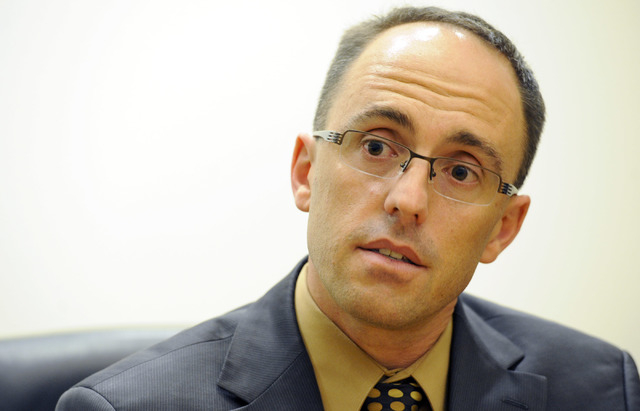Technical glitches snarl Silver State Health Insurance Exchange
Quick: What’s been the hardest part of getting the Silver State Health Insurance Exchange up and running?
Executive director Jon Hager has to laugh before he can answer.
“So many things,” he finally says.
And that’s when it’s up and running. It hasn’t exactly been smooth rolling for the exchange, which launched Oct. 1. Early interest has been stronger than exchange officials expected, Hager said, but technical glitches have been tough to overcome, and enrollment is low despite all the phone calls and website hits.
“It’s ‘whack-a-mole.’ We punch one thing down, and another thing pops up,” Hager said. “It’s challenging, but we’ve got a good team working on it.”
Here’s what they’ve had to work on: A Day One coding error that didn’t let servers share equal amounts of the morning’s high website traffic caused the account-creation function to stop intermittently. A firewall problem prevented transferring of the early high volume of calls to an overflow call center. Later in the first week, a software error kept some consumers from creating an account. The site went down for a while on Oct. 8 due to a platform server error. And a Web portal for insurance brokers had flaws that stopped them from getting codes to start accounts.
No one has been immune — Hager himself got stranded on the terms-of-use page for half an hour when he tried to open his account last week.
A lot of those early issues have been fixed, but as soon as exchange officials repair a bug, the changes force other issues that need patching, Hager said. The system shuts down routinely from 10 p.m. to 2 a.m. for fixes.
In its exchange woes, Nevada’s like pretty much every other state, said John Gorman, executive chairman of Gorman Health Group, a Washington, D.C.-based consulting firm that helps insurers and exchanges iron out technical hiccups.
High website volumes and software-design glitches plague the federal exchange that serves 36 states, with consumers reporting problems ranging from trouble setting up security questions to identity-checking issues that crash websites mid-enrollment.
“Nobody is happy with how this is going, and (exchange officials) are literally doing everything they can to rectify this stuff,” said Gorman, who has not consulted with the Silver State exchange.
In general, exchanges have used “a patchwork quilt of contractors and developers who started too late, weren’t coordinated, and tested within their own sandbox,” Gorman said. “And typically, when you see breakdowns like this, it’s a result of no one owning the end process to make sure all of these pieces hung together as one. That’s just a failure of management.”
Worse still, even as exchange officials mend codes during rollout, they’ll have to brace for weeks of ongoing hitches, Gorman said. After initial visits, some consumers set up accounts. The next step — an eligibility check — is “potentially uglier,” he said, because it involves cross-checking with a passel of other websites ranging from state Medicaid programs to Veterans Affairs. Other bugs could hatch during actual plan enrollment and first premium payment.
“It’s going to be like this about every two weeks until we get through the first month, and only then will things start to settle down,” Gorman said. “It could be the end of the first quarter before everything settles.”
The hassles are more than mere annoyance. Gorman said they’re tripping up the enrollment that’s supposed to pay for exchange operation. Nevada’s exchange aims to enroll 118,000 residents in state plans in the first year, 155,000 in 2015 and 169,000 in 2016. It has more than $80 million in federal grants to cover costs through 2014, but after that, it has to be self-sustaining, living on the 3 percent it charges on the premiums of plans it sells. If it doesn’t meet enrollment goals, it’ll have trouble covering costs.
So far, enrollment isn’t strong, though Hager said that’s no surprise this early in the game.
The latest available numbers as of Oct. 8 show 89,687 unique visitors to www.nevadahealthlink.com, but just 21,884 accounts created and 3,654 applications filed. At a Thursday meeting of the exchange’s board, Hager said 806 people have chosen actual plans and are ready to pay premiums in coming weeks. So the conversion rate from visitor to pending member is less than 1 percent.
Hager said he expects enrollment to pick up in mid- to late November, as the Dec. 15 deadline nears to buy coverage that takes effect Jan. 1.
For enrollment to improve, the exchange will have to work out its problems, and also offer coverage that consumers feel is worth the premium. Young people in particular have seen big jumps in their premiums: A $29-per-month catastrophic plan for a 25-year-old before Obamacare’s coverage mandates took effect now costs nearly $100.
But Gorman said he thinks the system will work out in the end.
“I haven’t seen anything fatal yet. It’s bumps in the road that no one will remember a year from now,” he said. “It’s not like shopping for a big-screen TV. This is health insurance. People need it. They’ll be back.”
Contact reporter Jennifer Robison at jrobison@reviewjournal.com. Follow @J_Robison1 on Twitter.




























